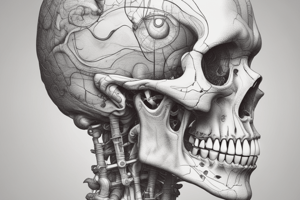Podcast
Questions and Answers
Which bones make up the pectoral girdle?
Which bones make up the pectoral girdle?
- Tibia and Fibula
- Clavicle and Scapula (correct)
- Humerus and Radius
- Femur and Patella
The upper extremity includes the femur.
The upper extremity includes the femur.
False (B)
What is the medial bone of the forearm?
What is the medial bone of the forearm?
Ulna
The __________ is a double curved bone connecting the arm to the body.
The __________ is a double curved bone connecting the arm to the body.
How many bones compose the appendicular skeleton?
How many bones compose the appendicular skeleton?
What part of the humerus articulates with the glenoid cavity of the scapula?
What part of the humerus articulates with the glenoid cavity of the scapula?
Which of the following is a part of the pelvis?
Which of the following is a part of the pelvis?
The __________ of the ulna is the proximal end.
The __________ of the ulna is the proximal end.
Which part of the upper extremity is referred to as the brachium?
Which part of the upper extremity is referred to as the brachium?
What is the primary function of the interosseous membrane?
What is the primary function of the interosseous membrane?
Flashcards are hidden until you start studying
Study Notes
Appendicular Skeleton Overview
- Composed of 126 bones in total.
- Includes pectoral girdles, upper extremity, pelvic girdle, and lower extremity.
Pectoral Girdles
- Contains clavicle and scapula.
- Clavicle:
- Doubly curved bone connecting the arm to the body.
- Medially attaches to the manubrium of the sternum.
- Laterally attaches to the acromion process of the scapula.
- Scapula (shoulder blade):
- Flat and triangular in shape.
- Articulates with the humerus at the shoulder.
- Important parts include:
- Glenoid cavity for humerus articulation.
- Spine and acromion processes.
- Coracoid process for muscle attachments.
Upper Extremity
-
Composed of arm (brachium) and forearm (antebrachium).
-
Major bones include humerus, ulna, and radius, along with carpal bones in the wrist.
-
Humerus:
- Articulates with scapula at shoulder and radius/ulna at elbow.
- Important features:
- Head, anatomical and surgical necks, greater and lesser tuberosities.
- Deltoid tuberosity for deltoid muscle attachment.
- Various fossae including coronoid and olecranon for elbow joint.
-
Ulna:
- Medial bone of the forearm.
- Key structures:
- Olecranon process at the proximal end.
- Trochlear notch which fits over the trochlea of the humerus.
- Styloid process at the medial aspect of the head.
-
Radius:
- Lateral bone of forearm, located on the thumb side.
- Important in forearm rotation (pronation and supination).
- "Funny bone" refers to the ulnar nerve near the elbow.
Pelvic Girdle
- Composed of three bones: ilium, ischium, and pubis.
- Provides structural support to the lower limbs and protects pelvic organs.
Lower Extremity
- Comprises femur, tibia, fibula, patella, tarsals, metatarsals, and phalanges.
- Critical for supporting body weight and facilitating movement.
- Important features of femur:
- Longest bone in body, articulates with the pelvis.
- Tibia and fibula:
- Tibia is the larger, weight-bearing bone of the lower leg.
- Fibula provides stability.
- Feet structure includes tarsals, metatarsals, and phalanges, crucial for balance and motion.
- Arches of the foot contribute to shock absorption and weight distribution.
Studying That Suits You
Use AI to generate personalized quizzes and flashcards to suit your learning preferences.




